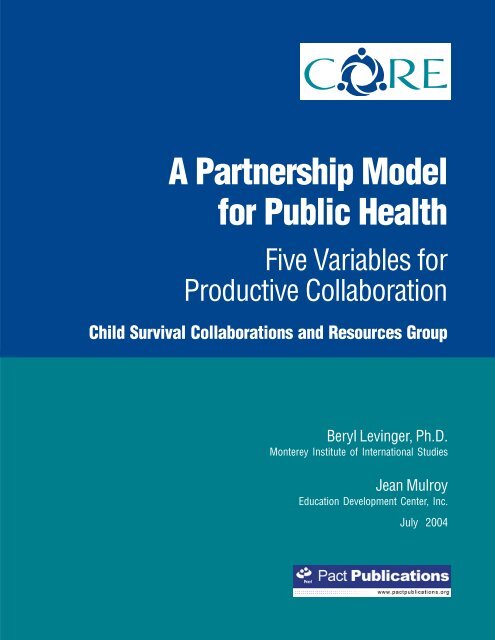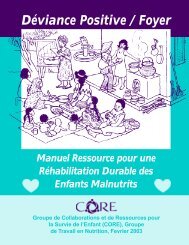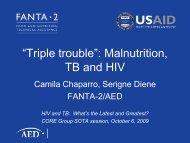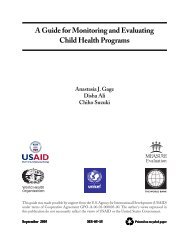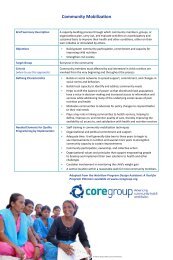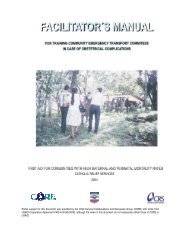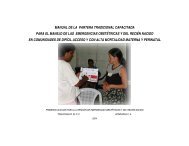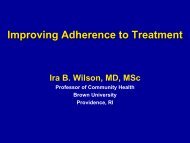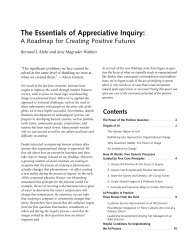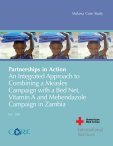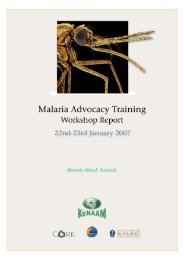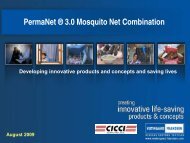A Partnership Model for Public Health - CORE Group
A Partnership Model for Public Health - CORE Group
A Partnership Model for Public Health - CORE Group
- No tags were found...
Create successful ePaper yourself
Turn your PDF publications into a flip-book with our unique Google optimized e-Paper software.
A <strong>Partnership</strong> <strong>Model</strong> <strong>for</strong> <strong>Public</strong> <strong>Health</strong>: Five Variables <strong>for</strong> Productive Collaboration© Copyright 2004 Pact <strong>Public</strong>ationsAll Rights ReservedFirst Printing/ June 2004Library of Congress Control Number: 2004106507ISBN 1-888753-390Pact <strong>Public</strong>ations1200 18th Street, NW, Suite 350Washington, DC 20036www.pactpublications.comPact <strong>Public</strong>ations is an integrated publishing house that facilitates the design, production and distribution of innovativeand progressive development materials. We are committed to offering customers the most appropriate educationalmaterials and training tools relevant to the ever-evolving field of international development.This paper is based on research carried out by the Education Development Center, Inc., funded byThe <strong>CORE</strong> <strong>Group</strong>, Washington, DC. <strong>Public</strong>ation was made possible through support provided by theBureau <strong>for</strong> Global <strong>Health</strong>, U.S. Agency <strong>for</strong> International Development, under Cooperative AgreementFAO-A00-98-00030. This paper does not necessarily represent the views or opinions of USAID.The <strong>CORE</strong> <strong>Group</strong>300 I Street NE, First FloorWashington, DC 20002Tel: 202.572.6330Fax: 202.572.6481www.coregroup.org
A <strong>Partnership</strong> <strong>Model</strong><strong>for</strong> <strong>Public</strong> <strong>Health</strong>Five Variables <strong>for</strong>Productive CollaborationChild Survival Collaborations and Resources <strong>Group</strong>Beryl Levinger, Ph.D.Monterey Institute of International StudiesJean MulroyEducation Development Center, Inc.July 2004
AcknowledgementsAbout The <strong>CORE</strong> <strong>Group</strong>The <strong>CORE</strong> <strong>Group</strong>, established in 1997, is composed of 35 US-based NGOs that implement child survival andchild health programs throughout the developing world. The <strong>CORE</strong> <strong>Group</strong> strengthens local capacity on a globalscale to measurably improve the health and well-being of children and women in developing countriesthrough collaborative NGO action and learning. <strong>CORE</strong> <strong>Group</strong> members serve a combined total of 250 millionwomen and children in over 140 countries.The authors thank Karen LeBan, Executive Director, The <strong>CORE</strong> <strong>Group</strong>, <strong>for</strong> providing access to in<strong>for</strong>mation anddocuments, as well as all <strong>CORE</strong> members who agreed to be interviewed in the course of our research.<strong>CORE</strong> <strong>Group</strong> MembersAdventist Development & Relief AgencyAfrican Medical and Research FoundationAfricareAga Khan Foundation, USAAmerican Red CrossCARE InternationalCatholic Relief ServicesChristian Children's FundConcern Worldwide USACounterpart International, Inc.CuramericasDoctors of the WorldFood <strong>for</strong> the Hungry InternationalFoundation of Compassionate American SamaritansFreedom from Hunger<strong>Health</strong> Alliance InternationalHellen Keller InternationalHesperian FoundationInternational Eye FoundationInternational Rescue CommitteeLa Leche League InternationalMedical Care Development, Inc.Mercy Corps InternationalMinnesota International <strong>Health</strong> VolunteersPartners <strong>for</strong> DevelopmentProgram <strong>for</strong> Appropriate Technology in <strong>Health</strong>Pearl S. Buck InternationalPLAN International USAPopulation Services InternationalProject Concern InternationalProject HOPESalvation Army World Service OfficeSave the ChildrenWorld Relief CorporationWorld Visioni
ContentsIntroduction................................................................................................................. 1Methods ..................................................................................................................... 3Discussion: A Framework to Analyze Networking and Partnering Behaviors ............................... 5<strong>CORE</strong> <strong>Group</strong> Case Study ................................................................................................. 9<strong>CORE</strong> <strong>Group</strong> Polio Partners Project ........................................................................................................... 9Positive Deviance/Hearth .......................................................................................................................... 11C-IMCI Framework .................................................................................................................................... 12Case Analysis ............................................................................................................ 15Conclusions: Lessons <strong>for</strong> Partnering and Policy Implications ............................................... 17References ............................................................................................................... 19About the AuthorsFIGURESFigure 1: <strong>Public</strong> <strong>Health</strong> <strong>Partnership</strong> Analysis Framework Variables .................................................... 7TABLESTable 1: Analysis of <strong>CORE</strong>’s Critical Partnering Practices ................................................................ 15ii
AcronymsCBOCGPP<strong>CORE</strong>IAFIMCILQASMCHMDGNGOOECDPAHOPDUNICEFUSAIDWHOcommunity-based organizationCore <strong>Group</strong> Polio PartnersChild Survival Collaborations and Resources <strong>Group</strong>Inter-American FoundationIntegrated Management of Childhood Illnesslot quality assurance samplingmaternal and child healthMillennium Development Goalnongovernmental organizationOrganisation <strong>for</strong> Economic Cooperation and DevelopmentPan American <strong>Health</strong> Organizationpositive devianceUnited Nations Children’s FundU.S. Agency <strong>for</strong> International DevelopmentWorld <strong>Health</strong> Organizationiii
Summaryhis paper presents a framework <strong>for</strong> assessing strategic partnering as a way to reach populations thathave been traditionally bypassed by maternal and child health (MCH) interventions. The framework isTapplied to the Child Survival Collaborations and Resources (<strong>CORE</strong>) <strong>Group</strong>, a network of 35 U.S.-based nongovernmentalorganizations (NGOs) engaged in MCH activities. Concrete examples are given of how this partnershipcontributes to improved outcomes <strong>for</strong> mothers and children; enhanced policy dialogue; expanded local andnational capacity; and the generation of new resources. The paper concludes with the identification of relevantlessons <strong>for</strong> MCH donors and NGOs that might wish to enter into similar partnership arrangements.iv
IntroductionTelecommunications professionals in theNorth know that their technology’s full potentialcannot be realized until the “lastmile barrier” is crossed. What is this elusive barrierand why is it so hard to traverse?The answer lies in the bottleneck found on that“last mile” of old copper phone lines that link individualsto ultra-modern fiber-optic networks. Suchnetworks, capable of linking farflunglocales, are relatively cheapand simple to build in relation to thecoverage they provide. In contrast,<strong>for</strong>ging that critical connection betweenan actual end-user and thenearest switch—usually not morethan a mile away—is far more complex.Solutions <strong>for</strong> covering this finalbit of terrain typically involvesignificant trade-offs between costand service quality (e.g., bandwidth).MATERNAL AND CHILDHEALTH PRACTITIONERSMaternal and child health (MCH) practitionersworking in developing countries today confront theirown version of this “last mile barrier.” Campaigns toimmunize children against major vaccine-preventablediseases are, illustratively, analogous to fiberopticnetworks. Such campaigns link a network (the<strong>Health</strong> Ministry’s infrastructure) to switching stations(clinics or health posts) in order to extend thenetwork’s coverage. Establishing these requisite linkagesis often quite demanding. However, a far moredaunting challenge lies in <strong>for</strong>ging the necessary connectionsbetween the clinic/switching station andthose end-user households that lie beyond the invis-WORKING IN DEVELOPINGCOUNTRIES TODAY CONFRONTTHEIR OWN VERSION OF THE“LAST MILE BARRIER.”ible boundary that separates “periphery” from “hinterland.”There are two other striking parallels between the“last mile barrier” issues of MCH and telecommunicationsspecialists. In both worlds, the extension ofservice coverage to “elusive” populations entails acompromise between af<strong>for</strong>dability and “bandwidth”(the potency of an intervention package). As well,professionals in both arenas pursuestrategies that combine “hard” and“soft” sciences to achieve the holygrail of universal coverage. The“soft” sciences include systematicand empirical thinking about suchissues as social policy and investmentpriorities, organizational capacitydevelopment, grassrootscoalition <strong>for</strong>mation, and interpersonalcommunication.This paper describes in detail one approach, strategicpartnering, that can be used to respond to theMCH “last mile” challenge. A framework <strong>for</strong> effectivenetworking in the public health field is offeredand then illustrated in the context of a case studythat details the work of the Child Survival Collaborationand Resources (<strong>CORE</strong>) <strong>Group</strong>. The paper concludeswith recommendations to public healthpractitioners interested in launching or refining fieldbasedinter-institutional partnering activities. We believethe partnering model offered here haswidespread applicability <strong>for</strong> public and private sectororganizations working in developing countries toimprove public health.1
MethodsThis study builds on three separate fieldbasedinvestigations conducted by the authorson the impact of strategic partnering<strong>for</strong> the rural poor in developing countries. Effectsconsidered largely relate to service coverage and theexpansion of favorable outcomes <strong>for</strong> vulnerablepopulations. These studies were undertaken over aperiod of three years, and each, in turn, will bebriefly described.The first, conducted <strong>for</strong> the Inter-American Foundation(IAF), examined the experiences of 12 unrelatedgrassroots developmentorientedpartnerships among nongovernmentalorganizations(NGOs), local governments and, insome cases, private sector businesses(Levinger and McLeod 2002). Fieldworkwas conducted in five LatinAmerican countries. That studyyielded robust insights on the stagesand types of partnerships as well asthe benefits and burdens associatedwith these relationships. These insightswere used to create the frameworkreported in this paper.A second investigation, conducted <strong>for</strong> the UnitedStates Agency <strong>for</strong> International Development (US-AID), detailed the partnering practices and benefitsof Katalysis, a Central American microfinance institutionsaffiliated with a single network (Levinger andMcLeod 2001). Fieldwork was carried out in threecountries. Both the IAF and USAID studies includedinterviews with representatives of partner institutionsand members of their beneficiary populations. Themethods developed <strong>for</strong> the USAID study (includingthematic analysis of partner documentation, participantobservation at <strong>for</strong>mal and in<strong>for</strong>mal networkFIELDWORK CONDUCTED INFIVE LATIN AMERICANCOUNTRIES YIELDED ROBUSTINSIGHTS ON THE STAGESAND TYPES OF PARTNERSHIPSAS WELL AS THE BENEFITSAND BURDENS ASSOCIATEDWITH THESE RELATIONSHIPS.events, and open-ended interviewing) were used inthe current inquiry.The third piece of research, carried out <strong>for</strong> theWorld Bank in 2003, focused on partnerships betweenbusinesses and the Ministry of Education in ElSalvador (Tsukamoto et al. 2003). The aim of thesecollaborative ef<strong>for</strong>ts was to improve education qualityand coverage at the primary and secondary levels.Unlike the earlier two studies, this work waschiefly concerned with the policy-related implicationsof partnering rather than questions of servicedelivery and extension of benefits tounder- or unserved populations. TheWorld Bank work enabled the researchteam to develop methods <strong>for</strong>relating partnering behaviors topolicies governing coverage and servicequality in relation to a singlesector (education).The present study involved testingconclusions drawn from the earlierresearch in the context of a newsector (public health) and a broaderrange of geographic regions (Asiaand Africa as well as Latin America). To do this, weapplied the approach followed in the USAID study(i.e., examining a single, multi-country network) andselected the <strong>CORE</strong> <strong>Group</strong> as the focus of this study.Research techniques included interviews with<strong>CORE</strong> partners; the use of participant-observer methodsat two of <strong>CORE</strong>’s annual meetings; a comprehensivereview of program documents provided by <strong>CORE</strong>partners (including project proposals, evaluations, and“lessons learned” compilations); as well as interviewswith leading edge public health practitioners familiarwith the field-based work of <strong>CORE</strong> members.3
Discussion: A Framework to Analyze Networkingand Partnering BehaviorsContextSignificant progress has been achieved in meetingMCH goals in many developing countries. Illustratively,childhood immunizations against the majorvaccine-preventable diseases increased from less than10 percent in the 1970s to nearly 75 percent in 2001(UNICEF 2004).Reported cases of polio fell by 99 percent duringthe 1990s, and deaths caused by diarrheal diseasefell by half. Withregard to underfivechild mortality,63 countriesachieved a onethirdreduction inthis decade,while another100 countriesachieved a onefifthreduction inthis same measure(UNICEF2002).SIGNIFICANT PROGRESS HASBEEN ACHIEVED IN MEETINGMATERNAL AND CHILDHEALTH GOALS IN MANY DE-VELOPING COUNTRIES. FOREXAMPLE, CHILDHOOD IMMU-NIZATIONS AGAINST THE MA-JOR VACCINE-PREVENTABLEDISEASES INCREASED FROMLESS THAN 10 PERCENT INTHE 1970S TO NEARLY 75PERCENT IN 2001.The MillenniumDevelopmentGoals (MDGs), endorsed by the United Nations,call <strong>for</strong> a reduction in maternal mortality by threequartersin 2015. To achieve this target, a great dealof attention must be paid to sub-Saharan Africa wherehalf the developing world’s maternal deaths occur—most in rural, outlying areas. Current data <strong>for</strong> that regionsuggest that one of every 100 live birthsculminates in the mother’s death, and pregnantwomen are 100 times more likely to die in pregnancyand childbirth there than their counterparts in high-incomeOrganisation <strong>for</strong> Economic Cooperation andDevelopment (OECD) countries, (United Nations DevelopmentProgramme 2003).Another MDG proposes a two-thirds reduction inchild mortality. Most attention will be focused ontwo priority areas, sub-Saharan Africa and SouthAsia. During the past decade, South Asia made sub-stantial gains, although sub-Saharan Africa appearsto have fallen further behind. Its current under-fivemortality rate is 170/1000.Many MCH problems affect disproportionatenumbers of the rural poor. Illustratively, less thanhalf of rural children in the developing world receivecare <strong>for</strong> acute respiratory infection, a major cause ofinfant and child mortality. In general, rural healthsystems do not have adequate staff or resources tomeet the health needs of women and children.(United Nations Development Programme 2003). Arecent developing country survey revealed that thepoorest 20 percent of the population always receivedless than 20 percent of the benefits associated withinvestments in public health. In countries with highinfant mortality rates, the bottom 20 percent account<strong>for</strong> less than 10 percent of hospital use (United NationsDevelopment Programme 2003).To meet the MDGs associated with MCH, threethings must occur: (1) new approaches to reachingtraditionally bypassed and under-served populationsmust be developed, tested, validated, and disseminated;(2) new institutional arrangements must becreated and tested toexpand access toMCH services, particularlyin rural areas;and (3) asupportive policy environmentmust becreated. Strategicpartnering, if donewell, has the potentialto make contributionsto all three ofthese areas.The FrameworkMANY MATERNAL AND CHILDHEALTH PROBLEMS AFFECTDISPROPORTIONATE NUMBERSOF THE RURAL POOR. LESSTHAN HALF OF RURAL CHIL-DREN IN THE DEVELOPINGWORLD RECEIVE CARE FORACUTE RESPIRATORY INFEC-TION, A MAJOR CAUSE OF IN-FANT AND CHILD MORTALITY.In earlier studies, the authors identified five sets ofvariables that proved useful in analyzing partnershipbehaviors and predicting partnership efficacy in expandingthe quantity and quality of services avail-5
A <strong>Partnership</strong> <strong>Model</strong> <strong>for</strong> <strong>Public</strong> <strong>Health</strong>able to traditionally bypassed groups. Each variableset will be described briefly and then applied to the<strong>CORE</strong> case.The first variable set, activity domains, focuseson the actual work of the partnership. The authors’earlier field-based research identified five areas <strong>for</strong>possible collaborative endeavors among partneringinstitutions:• Program Delivery: The direct provision tobeneficiaries of services linked to suchfundamental human needs as primary health care,livelihood support (including credit), and basiceducation.• Human Resource Development: These activitiesare designed to help individuals develop a deeperawareness of community assets as well as theskills and self-confidence needed to harness theseassets in pursuit of shared development goals.Empowerment is usually an explicit goal of workin this activity domain.• Resource Mobilization: This is the process ofsecuring the financial and technical supportrequired to carry out activities in any of the otherdomains.• Research and Innovation: These are activities thathelp local people and development practitionerswho work alongside them to test or assess newways of responding to priority needs andproblems. Work in this area is designed to yielddevelopment breakthroughs.• <strong>Public</strong> In<strong>for</strong>mation, Education, and Advocacy:These activities generally build upon research andfield-based program delivery experience. Often,there is a policy-oriented element to advocacy.Mobilizing public awareness, campaigning onbehalf of policy re<strong>for</strong>m, and advocating structuralchanges in institutions that impact on the lives ofthe poor are important components of this activitydomain.The second variable set, process factors, describethe way partners relate to one another. In earlier research,three process variables were deemed particularlyimportant: commonality of goals (but notnecessarily methods), complementarity of experiencesand resources, and trust. One of the most surprisingfindings from the authors’ initial field researchwas that most successful partnerships do nothave <strong>for</strong>mal hierarchical structures, nor are they generallybound by legal contracts (except in those instanceswhere funds were to be jointly managed).Instead, the high-functioning partnerships studiedwere built on strong trust that ensured accountabilityamong participants. The openness of such arrangementsenabled individual partners to flexibly drawon the complementary skills present in the partnership,allowing each entity to make significant contributionsto the common goal—even whencircumstances changed and new needs arose. Processfactors represent the minimum “relationship criteria”that must be met <strong>for</strong> entities to <strong>for</strong>m high per<strong>for</strong>mancepartnerships.Value-addingmechanisms comprisethe third variableset. Thesemechanisms can beused to explain whypartnerships, at theirbest, can accomplishmore than any individualactor in meetingthe needs ofbypassed populations.Each of thesevariables is brieflyset out below.ONE OF THE MOST SURPRIS-ING FINDINGS FROM INITIALFIELD RESEARCH WAS THATMOST SUCCESSFUL PARTNER-SHIPS DO NOT HAVE FORMALHIERARCHICAL STRUCTURES.INSTEAD, RESEARCHERSFOUND THAT HIGH-FUNCTION-ING PARTNERSHIPS WERE BUILTON STRONG TRUST THAT EN-SURED ACCOUNTABILITY.• Continuity: Whenever partners create newopportunities <strong>for</strong> the poor to maintain or expandupon skills and competencies acquired throughearlier development initiatives, continuity isachieved. Continuity entails planned ef<strong>for</strong>ts bypartners to consolidate development gains. Thus,<strong>for</strong> example, a community that has engaged inparticipatory planning and needs assessmentaround one set of issues deepens those capacitieswhen it has the opportunity to assess and plan inthe context of new challenges.• Comprehensiveness: The more comprehensive anintervention package, the greater the number ofcausal factors it addresses.• Coordination: Awareness of, and collaborationwith, other development actors in the community6
allows partners to achieve better coverage,develop more cost-effective programs, createeconomies of scale and build social capital thatcan be applied to future development challenges.• Risk mitigation: All development projects facethreats to success. <strong>Partnership</strong>s mitigate (i.e.,reduce or hedge) these risks, because sucharrangements lead to diversification of the actors’skill sets, contacts, spheres of influence, and priorexperience. Thus, actors become better able torespond to both internal weaknesses and thoserelated to design or management, as well asexternal threats. The greater the diversity amongpartners, the higher the risk mitigation potential ofthe partnership.The fourth variable set is partnership type. In earlierstudies the authors observed several differentphases of partnership development. It is important tonote that these phases need not occur in the sequencepresented below, and that it is not necessary <strong>for</strong> allpartnerships to pass through each of the followingphases. Furthermore, a given partnership may fluctuatebetween two phases (e.g., complementary andsynergistic partnership) as needs and resourceschange or as evaluation activities give rise to programmodification.• Potential partnership: Actors are aware of eachother but are not yet working closely together.• Nascent partnership: Actors are partnering but thepartnership’s efficiency is not maximized.Figure 1: <strong>Public</strong> <strong>Health</strong> <strong>Partnership</strong> Analysis Framework VariablesProcess factor:common goalsPrivate sectoractorsResearch andinnovationProcess factor:trustInternationalNGO actorsIn<strong>for</strong>mation andadvocacyNational NGOactors<strong>Partnership</strong> Activity DomainsCBO ActorsHumanresourcedevelopmentResourcemobilizationNational MoHactors<strong>Partnership</strong> type:potential$+Risk mitigation$+Continuity$+Comprehensiveness$+CoordinationDistrict-levelMOH actorsProgramdeliveryProcess factor:complementarityImproved service coverage and expandedbenefits to traditionally bypassed groupsLocalcommunity<strong>Partnership</strong> type:nascent<strong>Partnership</strong> type:complementary<strong>Partnership</strong> type:synergistic7
A <strong>Partnership</strong> <strong>Model</strong> <strong>for</strong> <strong>Public</strong> <strong>Health</strong>• Complementary partnership: Partners derivebenefits and increased impact through greaterattention to a fixed and relatively limited set ofactivity domains, generally program delivery andresource mobilization.• Synergistic partnership: Partners derive benefitsand increased impact by addressing complex,systemic development problems through theaddition of newactivitydomains (e.g.,advocacy andresearch).When a developmentef<strong>for</strong>t isrelatively straight<strong>for</strong>ward(i.e., fewcausal factors andproven technologies<strong>for</strong> addressingAWARENESS OF, AND COL-LABORATION WITH, OTHER DE-VELOPMENT ACTORS IN THECOMMUNITY ALLOWS PART-NERS TO ACHIEVE BETTERCOVERAGE, DEVELOP MORECOST-EFFECTIVE PROGRAMS,CREATE ECONOMIES OF SCALE,AND BUILD SOCIAL CAPITAL.them), complementary partnership may be the optimalarrangement. In contrast, when the developmentproblem is complex (i.e., multiple causal factors andfew technologies that are proven or af<strong>for</strong>dable to addressthem), a synergistic partnership is likely to representthe preferred response. In analyzing apartnership, it is useful to determine whether thepartnership type is well suited to the developmentchallenge the partnership is addressing.The final variable set to consider in partnershipanalysis is actor types. In order to achieve maximumrisk mitigation, actor diversity is desirable. In general,the ideal mix of actor types is determined bysuch factors as complementarities of skills and resources,ease of coordination, and the principle of“maximum tolerable unalikeness.” This principle isa reflection of the idea that the more unalike partnersare, the greater the risk mitigation. Suitable actortypes include (but are not limited to) national and internationalNGOs; representatives from different levelsof the Ministry of <strong>Health</strong> structure (national anddistrict levels, e.g.); business groups; communitybasedorganizations (CBOs); and other local communitygroups (both <strong>for</strong>mal and in<strong>for</strong>mal).Figure One (see page 7), summarizes the five setsof variables considered in the partnership analysisframework presented thus far.Consistent with this model, the following fivequestions provide a structure <strong>for</strong> predicting whether agiven MCH-focused set of actors is likely to achievemore through joint rather than individual ef<strong>for</strong>t:1. To what extent does the partnership mobilizeadditional resources?2. To what extent does the partnership organizemembers according to their comparativeadvantages?3. To what extent does the partnership bringpromising innovations to new beneficiary groups?4. To what extent does the partnership allowbeneficiary groups and partner organizations tobuild on previous gains?5. To what extent does the partnership createconditions <strong>for</strong> sustainable improvements in publichealth?8
The <strong>CORE</strong> <strong>Group</strong> Case StudyTHE <strong>CORE</strong> GROUP BEGAN ALMOST 20 YEARS AGO AS AN INFORMAL NETWORK OF CHILD SURVIVAL NGOSWHO WANTED TO SHARE TECHNICAL INFORMATION AND LESSONS FROM THE FIELD. TODAY, <strong>CORE</strong> DEVELOPSSTATE-OF-THE-ART KNOWLEDGE AMONG ITS NGO MEMBERS, SYNTHESIZES NGO EXPERIENCES AND PRO-MOTES RECOMMENDED PRACTICES, AND FACILITATES LEARNING AND COLLECTIVE ACTION AMONG PUBLICHEALTH ACTORS.Introducing <strong>CORE</strong>The <strong>CORE</strong> <strong>Group</strong> is composed of 35 US-basedNGOs that implement programs to improve thehealth of children and women throughout the developingworld. These groups serve a combined total of250 million women and children in over 140 countries.The founding organizations began their collaborationin 1985 when they participated in a seriesof annual workshops <strong>for</strong> grantees sponsored by theUSAID Child Survival Program (Shanklin 2002).These workshops exposed participants to the benefitsof sharing technical in<strong>for</strong>mation and lessons learnedthrough field-based projects. In 1990 these NGOs beganorganizing to advocate <strong>for</strong> changes withinUSAID’s child survival program. An in<strong>for</strong>mal entityknown as the Collaborative <strong>Group</strong> emerged fromthese discussions.In 1996, Collaborative <strong>Group</strong> members approachedUSAID with a request <strong>for</strong> financial supportto create a <strong>for</strong>mal network. One year later, <strong>CORE</strong>received its first grant. Its first workshop, held laterthat year, was organized around thematic clusters(e.g., Nutrition, Social and Behavioral Change).These clusters later developed into the Working<strong>Group</strong>s that <strong>for</strong>m the nucleus of <strong>CORE</strong>’s technicalactivities today (Shanklin 2002). This working groupstructure allows <strong>CORE</strong> to capitalize on the strengthsand comparative advantages of members across technicalareas.Over the last five years, the network has evolvedsignificantly as it has attracted new donor funds andmembers. Its working groups on technical activitiesand innovations have expanded. <strong>CORE</strong> now has asmall staff and a governance structure that includes aboard of directors selected from and elected by itsmembership. Its current focus is on developing stateof-the-artknowledge, products, and collaborative services;serving as a communication link to synthesizeexperiences and promote recommended practices; facilitatingdialogue, learning and collective actionamong public health actors; and advocating on globalhealth policy issues.An in-depth review of three <strong>CORE</strong> activitiesThree specific examples of <strong>CORE</strong>’s MCH projectsare presented here to highlight features of thepartnership’s operations.1. The <strong>CORE</strong> <strong>Group</strong> Polio Partners (CGPP)ProjectThis ef<strong>for</strong>t targets potential polio victims in remote,resistant, dangerous, and marginalized communitiesthat have not yet been reached by global eradicationef<strong>for</strong>ts. A key strategic element of the approach entailsworking through <strong>CORE</strong> NGO members withthe strongest ties to target group communities andthe institutions that serve them.<strong>CORE</strong> staff identified appropriate NGO membersand invited them to participate in the initiativethrough the joint creation of project proposals thatreflected global and country polio eradication priorities.Participating NGOs were able to build on theircollective, diverse experiences in applying the technicalpackage in multiple geographic regions. The proposalsthat met the program’s technical criteria werebundled together to create a single, multi-countryprogram. This bundling model allowed smallerNGOs to contribute to the joint ef<strong>for</strong>t while allowing9
A <strong>Partnership</strong> <strong>Model</strong> <strong>for</strong> <strong>Public</strong> <strong>Health</strong>THE <strong>CORE</strong> GROUP POLIOPARTNERS PROJECT CON-DUCTS ITS WORK THROUGH<strong>CORE</strong> NGO MEMBERSWITH THE STRONGEST TIES TOTARGET GROUP COMMUNITIESeach participating organizationthe opportunityto exercise itsunique expertise(<strong>CORE</strong> <strong>Group</strong> PolioPartners 2002a).The presence of a<strong>CORE</strong> Secretariat remainsan importantelement in buildingtrust among the partnersand facilitatingthe requisite coordinationof ef<strong>for</strong>ts. Thecombination ofbundled proposalsand centralized staff support has proven “synergistic... having one without the other is less effective. TheSecretariat provides the shared goals necessary <strong>for</strong> abundled proposal and results-oriented collaboration.Implementation by the consortium of activities describedin the bundled proposal provides the sharedexperiences, challenges and needs that provide directionand priorities <strong>for</strong> the Secretariat” (<strong>CORE</strong> <strong>Group</strong>Polio Partners 2002a p. 13).AND THE INSTITUTIONS THATSERVE THEM. THE PRESENCEOF A <strong>CORE</strong> SECRETARIAT ISAN IMPORTANT ELEMENT INBUILDING TRUST AMONG PART-NERS AND FACILITATING COOR-DINATION.Another important component of this initiative hasbeen the systematic introduction of technical innovations.One example is Lot Quality Assurance Sampling(LQAS), a rapid, simple statistical samplingmethod that is used to draw important conclusionsfrom small samples and has proven valuable in assessingand selecting geographic areas <strong>for</strong> program coverage(Valadez, 1994). <strong>CORE</strong> members have not onlyused the technique in projects but have also trainedpersonnel from NGOs and Ministries of <strong>Health</strong> in itsuse. The sharing of in<strong>for</strong>mation––particularly technicalinnovations such as LQAS––with local organizationsand Ministries of <strong>Health</strong> has, according tomembers, contributed to greater understanding ofchildhood epidemiology at the local and national levels.Participating NGOs report improvements in programcoverage, quality, and associated outcomes. Thehealth outcomes are well documented. Project beneficiariesnumber nearly 14 million under-five children(<strong>CORE</strong> <strong>Group</strong> Polio Partners 2002a p. 1).In 2002, most of the seven projects linked to thisinitiative supported planning; identified pockets oflow coverage; created local partnerships; and conductedsocial mobilization <strong>for</strong> supplemental immunizationcampaigns. Four country projects conductedsynchronized vaccination campaigns (<strong>CORE</strong> <strong>Group</strong>Polio Partners 2002b, p. 8). Although the initiativefell slightly short of its objective — seven new collaborativeentities <strong>for</strong> the year — six of seven projectcountries did establish local NGO consortia, which,in turn, conducted technical and management training;mobilized demand <strong>for</strong> routine immunizations;improved vaccine logistics systems; and encouragedcommunity contributionto delivery ofroutine immunizations(<strong>CORE</strong> <strong>Group</strong>Polio Partners 2002bpp. 3–5). The experiencealso resultedin key lessons aboutthe time needed toestablish trustamong partners, theimportance of ashared purpose, andthe useful role that“honest broker” organizationscan play(<strong>CORE</strong> <strong>Group</strong> Polio Partners 2002a).SIX OF SEVEN <strong>CORE</strong> POLIOPROJECT COUNTRIES ESTAB-LISHED LOCAL NGO CON-SORTIA, WHICH CONDUCTTECHNICAL AND MANAGE-MENT TRAINING; MOBILIZEDEMAND FOR ROUTINE IMMU-NIZATIONS; IMPROVE VACCINELOGISTICS SYSTEMS; AND EN-COURAGE COMMUNITY CON-TRIBUTION TO DELIVERY OFROUTINE IMMUNIZATIONS.CGPP’s approach to achieving greater polio vaccinationcoverage in high-risk areas and hard-toreachpopulations entails strengthening localcapacity on a global scale. A key feature of the initiativeis the coordination and mobilization of communityinvolvement in mass oral polio vaccineimmunization campaigns. Local interventions incorporateseven critical components: building partnerships;strengthening existing immunization systems;supporting supplemental immunization ef<strong>for</strong>ts; helpingimprove the timeliness of case detection and reporting;providing support to families with paralyzedchildren; participating in national and regional certificationactivities; and improving documentation(<strong>CORE</strong> <strong>Group</strong> Polio Partners 2002b, pp. 1–2).In addition, the project takes into account the interrelationshipsbetween polio and other developmentproblems. Representatives of this <strong>CORE</strong> initiative participatein the Inter-Agency Coordinating Committee<strong>for</strong> Immunization where they help to build bridgesamong local-, country-, regional- and global-level ac-10
tors. The strength and depth of the partnership allowsparticipating institutions to exert policy-level influencethat they would not have absent this collaboration.2. Positive Deviance/HearthThese are two public health methodologies withbroad applicability, which have been used with particulareffectiveness in rehabilitating malnourishedchildren. <strong>CORE</strong>’s approach to promoting these methodologieswill be examined in this section.Positive Deviance (PD) is a strengths-based approachbased on the theory that in many resourcepoorcommunities there are some families orindividuals who “employ uncommon, beneficialpractices that allow them and their children to havebetter health as compared to their similarly impoverishedneighbors.” PD practitioners seek to help communitiesunderstand these families’ or individuals’practices and disseminatethemPOSITIVE DEVIANCE IS BASED throughout theirON THE THEORY THAT, IN communities. ThisMANY RESOURCE-POOR COM- is done by determininga specific desir-MUNITIES, THERE ARE SOMEFAMILIES OR INDIVIDUALS WHO able nutrition“EMPLOY UNCOMMON, BEN- outcome, identifyinga few individu-EFICIAL PRACTICES THAT AL-LOW THEM AND THEIRals who haveCHILDREN TO HAVE BETTER achieved the goodHEALTH AS COMPARED TO outcome despiteTHEIR SIMILARLY IMPOVER- high risk, and thenISHED NEIGHBORS.”conducting a PD inquiryinto the behaviorsthat explainthe good outcome. Behaviors that can readily be replicatedby neighbors become the focal point of newinterventions designed to promote their broaderadoption (Marsh and Schroeder 2002).Hearth is an implementation strategy that mobilizescommunity volunteers and mothers or caregiversof malnourished children to practice new health behaviorsby bringing them together in a structured, safeenvironment to learn new cooking, feeding, hygieneand caring behaviors (<strong>CORE</strong> <strong>Group</strong> 2002a). Hearthsessions usually consist of nutritional rehabilitationand education over a 12-day period followed by homevisits (Nutrition Working <strong>Group</strong>, 2003).PD/Hearth (PD/H) was developed over many yearsby several applied nutritionists. Although the UnitedNations Children’s Fund (UNICEF) funded researchinto the methodology in the 1980s, the first <strong>for</strong>malPD/H programs weren’t initiated until the early 1990sin Bangladesh, Haiti, and Vietnam (<strong>CORE</strong> <strong>Group</strong> andBASICS II 2000). In Vietnam, <strong>CORE</strong> member Save theChildren applied the approach to 14 communities.Documented outcomes of PD/H include reductions inthe incidence of malnutrition and faster growth ratesamong children. As PD/H proved successful in rehabilitatingmalnourished children, other NGOs becameinterested, and SC began using the “Living University”as a dissemination tool. The Living Universityuses engaging, interactive techniques to teach thePD/H framework to managers and supervisors, whoin turn train volunteers to implement the program atthe community level.The <strong>CORE</strong> <strong>Group</strong>’s involvement in the PD/Hmethodology is on two parallel tracks: 14 <strong>CORE</strong>member NGOs individually manage PD/H programsaround the world, and the <strong>CORE</strong> Nutrition Working<strong>Group</strong> devotes significant resources to analyzing bestpractices, <strong>for</strong>mulating strategies and disseminatingin<strong>for</strong>mation about PD/H techniques. Working <strong>Group</strong>members meet regularly to discuss such technicaland implementation issues as monitoring and evaluationmethods (<strong>CORE</strong> <strong>Group</strong> 2002a, pp. 21–22). Disseminationmethods include the Living University,manuals, studies, field visits, consultant visits, training<strong>for</strong> district and community program managers,and training of trainers.<strong>CORE</strong>’s role in global PD/H ef<strong>for</strong>ts exemplifies itsunique approach to scaling up the application ofpromising approachesthat have been successfullydemonstrated atthe local level. Thegroup seeks to extendcoverage by conductingoutreach to other actorswho implement programs.Outreach entailstraining,advocacy, knowledgemanagement, and technicalsupport.<strong>CORE</strong>’S ROLE IN GLOBALPOSITIVE DEVIANCE/HEARTH EFFORTS EXEM-PLIFIES ITS UNIQUE AP-PROACH TO SCALING UPTHE APPLICATION OFPROMISING APPROACHESTHAT HAVE BEEN SUCCESS-FULLY DEMONSTRATED ATTHE LOCAL LEVEL.11
A <strong>Partnership</strong> <strong>Model</strong> <strong>for</strong> <strong>Public</strong> <strong>Health</strong>In 2003, <strong>CORE</strong>’s Nutrition Working <strong>Group</strong> releasedPositive Deviance/Hearth: A Resource Guide<strong>for</strong> Sustainably Rehabilitating Malnourished Children.This comprehensive, field-oriented manualenunciates the “essential elements” that are fundamentalto any PD/H program.3. The Community IMCI FrameworkIntegrated Management of Childhood Illness (IMCI),a World <strong>Health</strong> Organization (WHO) and UNICEFinitiative launched in the early 1990s, aims to significantlyreduce mortality and morbidity associatedwith the five major causes of disease in children underfive. Over the years, the program has been subdividedinto three components: improving casemanagement skills of health workers; improvinghealth system support <strong>for</strong> high-quality care <strong>for</strong> childrencoming to health facilities or outreach sites; andimproving household and community practices relatedto child health, nutrition, and development.<strong>CORE</strong> is primarily involved in activities relatedto the third component, referred to as Household andCommunity IMCI. <strong>CORE</strong>’s IMCIWorking <strong>Group</strong> activities addresspolicy and service delivery issues atthe global and local levels. Globally,the <strong>CORE</strong> Working <strong>Group</strong> participatesin the official InteragencyWorking <strong>Group</strong> (IAWG) charged byWHO and UNICEF with guidingIMCI policy and overseeing earlyimplementation (Winch et al. 2002).At the regional level, <strong>CORE</strong> hasworked with the Pan American<strong>Health</strong> Organization (PAHO) to testtechnical tools and to <strong>for</strong>mulatecommunication and behavioralchange strategies. At the nationallevel, <strong>CORE</strong> members have participated in advocacytask <strong>for</strong>ces to help district- and community-level actorsinfluence national policy; have worked withMinistries of <strong>Health</strong> to adapt technical tools <strong>for</strong> useby community health workers; and have helped identifyappropriate tools and practices <strong>for</strong> countries. Atthe district and community levels, <strong>CORE</strong> membershave engaged with Ministries of <strong>Health</strong> and other localactors (Child Survival Technical Support Project2001).<strong>CORE</strong> MEMBERS HAVEHELPED DISTRICT- AND COM-MUNITY-LEVEL ACTORS INFLU-ENCE NATIONAL POLICY ONHOUSEHOLD AND COMMU-NITY INTEGRATED MANAGE-MENT OF CHILDHOODILLNESS. MEMBERS HAVE ALSOWORKED WITH MINISTRIES OFHEALTH TO ADAPT TECHNI-CAL TOOLS FOR USE BY COM-MUNITY HEALTH WORKERS.12One of <strong>CORE</strong>’s key contributions in this area hasbeen its work on a descriptive IMCI implementationframework based on members’ field experiences(Winch et al. 2001). A key aspect of the frameworkis Community Mobilization: “maximum communityleadership in the process of identifying, planning, organizing,and mobilizing resources <strong>for</strong> communitylevelhealth activities.” Organizations using theframework are urged to promote community involvementin such tasks as identifying health needs andpriorities; community surveillance; and investigationsinto causes of child mortality (Child SurvivalTechnical Support Project, 2001). This emphasis oncommunity involvement supports an increased levelof sustainability in health ef<strong>for</strong>ts, thereby allowingprogram outcomes to be maintained on the locallevel. In addition, <strong>CORE</strong> and its membership havebeen heavily involved in IMCI policy, planning, andevaluation meetings at the local, regional, nationaland international levels. These contacts have given<strong>CORE</strong> the opportunity to disseminate communitybasedperspectives to national and internationalpolicymakers.The framework includes somestandard implementation proceduresand a consensus-building process focusedon uniting diverse partnersaround improving child health andnutrition at the district level (ChildSurvival Technical Support Project2001). The framework groups IMCIimplementation activities aroundthree key linked requisite elements:improving partnerships betweenhealth facilities and the communitiesthey serve; increasing appropriate,accessible care and in<strong>for</strong>mationfrom community-based providers;and integrated promotion of keyfamily practices critical <strong>for</strong> child health and nutrition(Winch et al. 2001). The framework also stressesthe importance of “optimizing a multi-sectoral plat<strong>for</strong>m.”Practical application of the framework has led toimproved family and community practices in relationto all three elements. For example, with regardto strengthening the partnership between health facilitiesand the communities they serve, a <strong>CORE</strong>
member, Project HOPE, trained staffat a local clinic in the DominicanRepublic in IMCI, which then usedthe IMCI <strong>for</strong>m and codes to recordin<strong>for</strong>mation about children visitingthe clinic. The clinic’s communityoutreach staff were also trained touse the <strong>for</strong>m to identify childrenneeding follow up visits. As a resultof the methodology, research foundsignificant increases in the proportionof caretakers who brought their childrenback <strong>for</strong> follow up visits.Another key element of the frameworkis the Multi-Sectoral Plat<strong>for</strong>m, an explicit ef<strong>for</strong>tby the IMCI community to “think and work beyondthe health sector” (Child Survival Technical SupportProject 2001). The Plat<strong>for</strong>m “focuses on innovativestrategies <strong>for</strong> linking broader development activitieswith child health and nutrition,” based on the principlethat “people may find it difficult or impossibleto adopt new [health promoting] behaviors if otherproblems that they face, such as food insecurity orlack of access to clean water, are not also addressed”IN A 2001–2002 SURVEY,<strong>CORE</strong> GROUP MEMBERS RE-PORTED THAT THE IMCIFRAMEWORK HAD BEEN VALU-ABLE IN PROVIDING THEMWITH A COMMON LANGUAGEFOR DESCRIBING THEIR CUR-RENT ACTIVITIES AND EX-PLAINING HOUSEHOLD ANDCOMMUNITY IMCI TO OUT-SIDE ACTORS.(Child Survival Technical SupportProject 2001). The framework proposesmany ways in which NGOscan collaborate with local governmentsand national Ministries inmultiple sectors.In the <strong>CORE</strong> 2001–2002 membersurvey, respondents reportedthat the Framework had been valuablein providing them with a commonlanguage <strong>for</strong> describing theircurrent activities and explainingHH/C IMCI to outside actors, discussingchild health issues withMinistries of <strong>Health</strong> and other collaborators, designinginterventions to address specific situations, andarticulating an overall vision <strong>for</strong> community-basedchild health work (Winch et al. 2002). In an internalsurvey of <strong>CORE</strong> members, 79 percent of respondentsreported using <strong>CORE</strong>-supported materials in implementationof IMCI, and each of them had, in turn,trained approximately four to five other organizationsin the methodology (<strong>CORE</strong> <strong>Group</strong> 2002b p.22).13
Case Analysishe <strong>CORE</strong> case, in many respects, represents“best partnership practice” in terms of thefive sets of variables presented earlier. Fur- Tthermore, the case illustrates that innovative, synergisticpartnerships can make a significant contributionin improving the coverage and quality of MCHservices, particularly with respect to the “last mile”populations of rural sub-Saharan Africa and Asia.Table 1 summarizes the case in terms of the keypartnering variables.Table 1: Analysis of <strong>CORE</strong>’s Critical Partnering PracticesActivitydomains<strong>Partnership</strong>typeActorsProcessfactorsValue-addingmechanismsImpact onservicecoverageand qualityProgram deliverySubstantialinvolvement in fieldbasedserviceprovision woveninto majorinitiativesHuman resourcedevelopmentEmphasis placedon communityempowerment,local skillsbuilding,andpolicy-orientedtrainingResourcemobilizationPractice of “bundling”proposalsand working jointlyto secure fundsresulted in substantialin-flows of newresources15Research andinnovationEmphasis given tobringing promisinginnovations to scaleand to refininginternationallyaccepted methodologiesIn<strong>for</strong>mation andadvocacySignificant attentiongiven to documentationof lessonslearned andparticipation inpolicy-setting bodiesInitial contact among founding members at USAID Child Survival workshop illustrated a potentialpartnership that entered into the nascent phase when the Collaborative <strong>Group</strong> was established. The threeinitiatives presented here represent synergistic partnership as there is significant activity in all five activitydomains. This partnership is probably most appropriate <strong>for</strong> reaching “last mile” populations.<strong>CORE</strong> strengthens linkages among US-based NGOs. However, it also gives significant attention to thedevelopment and strengthening of linkages with the international MCH community; national and districtlevelministerial personnel; community actors; and, through the in-country collaborative groups establishedin support of the initiatives described, national organizations. Thus far, little outreach is observed to theprivate sector.Common goals Trust ComplementarityMembers share astrong commitmentto local empowermentand community-basedapproaches toMCH. A missionstatement sets <strong>for</strong>ththe group’s sharedgoals and vision.<strong>CORE</strong> members began workingtogether 20 years ago. The shift fromin<strong>for</strong>mal to <strong>for</strong>mal network took fiveyears. This time was a vital investment,since member NGOs often compete <strong>for</strong>USAID and other funds and there<strong>for</strong>emight view one other as competitors.<strong>CORE</strong>’s policy of transparency indecision-making allowed members tobuild personal relationships and trust inone another, and to establish a cultureof collaboration on <strong>CORE</strong> projectsregardless of their competitive stance visa vis other activities.<strong>CORE</strong>’s members have different butcomplementary resources, strengths andexperiences. Illustratively, some membershave strong technical skills in a particularmethodology, but, because of factorsrelated to size and history, do not have thecapacity to scale-up promising innovationson their own. Other members havesignificant ties and presence in traditionallybypassed or under-served communities butlack the technical capacity to introducepromising new MCH methodologies tocommunities they serve.Risk mitigation Continuity Comprehensiveness CoordinationDiversity of partners’experiences, resources,networks, and rolesreduces risks to projectactivities associated withinadequate design orchanges in the externalenvironment.In most instances,<strong>CORE</strong> activitiesbuilt upon earlierdevelopmentinitiatives servingthe samepopulations.All 3 initiatives involvea rich interventionpackage that includescommunity mobilization,local capacitybuilding, direct servicedelivery, and the<strong>for</strong>ging of new institutionallinkages.<strong>CORE</strong> initiatives demonstratemultiple mechanisms to promotecoordination at national andinternational levels. These includeWorking <strong>Group</strong> meetings,publications, and in-country task<strong>for</strong>ces. <strong>CORE</strong> secretariat staff playan important role in stimulatingtimely and useful partnercommunication.All 3 initiatives have a distinct impact on extending service coverage and quality. This is accomplished intwo ways: through direct service provision to typically bypassed populations, and through “indirectscaling,” which entails systematic outreach, training, and in<strong>for</strong>mation dissemination to potentialreplicators.
Conclusions: Lessons <strong>for</strong> Partnering and Policy Implicationshere are many replicable elements of the<strong>CORE</strong> model. For a partnership to haveadded value, it must demonstrate its ability Tto mobilize resources; organize members accordingto their comparative advantages; bring promising innovationsto new beneficiary groups; allow membersto build on previous gains; and create conditions <strong>for</strong>sustainable improvements in public health. Thesetasks can be readily accomplished if sufficient attentionis paid to the five sets of partnership variablesoutlined in this article.SYNERGISTIC PARTNERSHIPSCAN MAKE A SIGNIFICANTCONTRIBUTION IN IMPROVINGTHE COVERAGE AND QUALITYOF MATERNAL AND CHILDHEALTH SERVICES, PARTICU-LARLY WITH RESPECT TO THE“LAST MILE” POPULATIONS OFRURAL SUB-SAHARAN AFRICAAND ASIA.Some of the details of <strong>CORE</strong>’s partnership modeldeserve particular mention, because they can be readilyreplicated and confer significant advantages. The divisionof labor withinthe partnership betweena secretariatand thematically focusedworkinggroups facilitates theorganization ofmembers accordingto their comparativeadvantages.<strong>CORE</strong>’s policyof openly sharingtechnical innovationsallows <strong>for</strong>promising methodologies to be introduced and replicatedmore rapidly than is generally the case with“pilot” or demonstration projects. The partnership’sstrong emphasis on disseminating effective MCHtools and methods along with its culture of trust havealso allowed members to build on previous gains. Finally,<strong>CORE</strong>’s wide range of relationships at the local,district, national and international levels providean opportunity <strong>for</strong> it to influence policy and shape acontext conducive to sustainable improvements inMCH outcomes.Black et al. (1993) argue that the key to savingchildren’s lives is not technological innovation but effectivemanagement of the knowledge that is alreadyavailable. Effective partnerships along the lines ofthe <strong>CORE</strong> model could play an important role in thisarea.Successful replication by other organizationalpublic health actors will, however, depend on fivecritical factors:• the development of mechanisms that fostersimultaneous outreach to local, traditionallybypassed communities and the health sector“influentials” who set global and nationalpriorities;• the ability to per<strong>for</strong>m the reconnaissance requiredto identify promising innovations that are ready<strong>for</strong> scale-up;• the ability to access funds to cover the costs of aSecretariat;• the ability to strike a suitable balance betweenservice provision to beneficiary groups (anexternal focus) and activities that build membercapacity (an internal focus); and• the ability to allow the partnership to evolve at apace that is appropriate <strong>for</strong> building trust andcohesion.Bilateral and multilateral support <strong>for</strong> strategicpartnering is likely to be a cost-effective investmentin securing the well being of bypassed mothers andchildren if these five elements are in place and if prospectivepartners are committed to paying close attentionto the five sets of partnership variablesdiscussed earlier. If these conditions prevail, strategicpartnering will one day be considered as critical togood outcomes <strong>for</strong> mothers and children as “growthcharting.”17
ReferencesBell PD, Stokes C. 2001. Melding Disparate Cultures andCapacities to Create Global <strong>Health</strong> <strong>Partnership</strong>s.American Journal of <strong>Public</strong> <strong>Health</strong> 91: 15524.Black RE, Morris SS, Bryce J. 2003. Where and why are10 million children dying every year? The Lancet 361:2226–34.Child Survival Technical Support (CSTS) Project. 2001.Reaching Communities <strong>for</strong> Child <strong>Health</strong> and Nutrition:A Framework <strong>for</strong> Household and CommunityIMCI. CSTS Project: Calverton, MD.<strong>CORE</strong> <strong>Group</strong>. 2002a. Positive Deviance/Hearth <strong>for</strong> Nutrition:Technical Advisory <strong>Group</strong> Meeting. Washington,D.C.: The <strong>CORE</strong> <strong>Group</strong>. Unpublisheddocument.<strong>CORE</strong> <strong>Group</strong>. 2002b. Benefits Survey <strong>for</strong> <strong>CORE</strong> Members.Washington, D.C.: The <strong>CORE</strong> <strong>Group</strong>. Unpublisheddocument.<strong>CORE</strong> <strong>Group</strong> and BASICS II. 2000. Hearth Technical Advisory<strong>Group</strong> Meeting. April 11–12, 2000. Arlington,VA: BASICS II. Unpublished document.<strong>CORE</strong> <strong>Group</strong> Polio Partners. 2002a. Lessons Learned:<strong>CORE</strong> Polio Partners Project Midterm Review:1998–2002. Washington, D.C.: The <strong>CORE</strong> <strong>Group</strong>.Unpublished document.<strong>CORE</strong> <strong>Group</strong> Polio Partners. 2002b. <strong>CORE</strong> <strong>Group</strong> PolioPartners Project: 3 rd and 4 th Quarter Narrative Report,FY 2002, April–September 2002. Washington,D.C.: The <strong>CORE</strong> <strong>Group</strong>. Unpublished document.Department of Child and Adolescent <strong>Health</strong> and Development,World <strong>Health</strong> Organization. 1999. IntegratedManagement of Childhood Illness and <strong>Health</strong> SectorRe<strong>for</strong>m. IMCI In<strong>for</strong>mation. Geneva: World <strong>Health</strong>Organization.Jones G, Steketee RW, Black RE, Bhutta ZA, Morris SS,and the Bellagio Child Survival Study <strong>Group</strong>. 2003.How many child deaths can we prevent this year? TheLancet 362: 65–71.Levinger B, McLeod J. 2001. “<strong>Partnership</strong> Principles,Practices and Methodology: A Southern Perspective.”[Online] Available at http://www.dec.org/pdf_docs/PDABZ297.pdf [Accessed 2/13/04]Levinger B, McLeod J. 2002. Togetherness: How Governments,Corporations and NGOs Partner to SupportSustainable Development in Latin America. Washington,D.C.: Inter-American Foundation.Marsh DR, Schroeder DG. 2002. The positive devianceapproach to improve health outcomes: experienceand evidence from the field. In: Food and NutritionBulletin 23: 3–5.Nutrition Working <strong>Group</strong>, Child Survival Collaborationsand Resources <strong>Group</strong> (<strong>CORE</strong>) 2003. Positive Deviance/Hearth:A Resource Guide <strong>for</strong> Sustainably RehabilitatingMalnourished Children. Washington,D.C.: The <strong>CORE</strong> <strong>Group</strong>.Shanklin D. A Brief History of The <strong>CORE</strong> <strong>Group</strong>: A R/evolution in Collaboration Among U.S.-Based InternationalChild Survival <strong>Health</strong> Service Providers.Washington, D.C.: The <strong>CORE</strong> <strong>Group</strong>. Unpublisheddocument.Tsukamoto M, Twose N, Levinger B, Mulroy J. 2003Ministry of Education Framework <strong>for</strong> a CSR NationalAction Plan, World Bank Technical AssistanceNote. Washington, D.C.: World Bank.United Nations Development Programme. 2003. MillenniumDevelopment Goals: A compact among nationsto end human poverty. Human Development Report2003. New York: Ox<strong>for</strong>d University Press.UNICEF. 2002 “United Nations Special Session on Children.”8–10 May 2002. [Online] Available at http://www.unicef.org/specialsession/about/end-decaderesults.htm[Accessed 2/18/04]UNICEF. 2004 “Expanding Immunization Coverage.”[Online] Available at http://www.unicef.org/immunization/index_coverage.html[Accessed 2/14/04]Valadez J, Bamberger M. 1994. Monitoring and EvaluatingSocial Programs in Developing Countries. Washington,D.C.: Economic Development Institute of theWorld Bank.Winch P, LeBan K, Kusha B, et al. 2001. Reaching Communities<strong>for</strong> Child <strong>Health</strong>: Advancing PVO/NGOTechnical Capacity and Leadership <strong>for</strong> Householdand Community Integrated Management of ChildhoodIllness (HH/C IMCI). Calverton, MD: CSTSProject. April 2001.Winch P, LeBan K, Casazza L, Walker L, Pearcy K. 2002.An implementation framework <strong>for</strong> household andcommunity integrated management of childhood illness.<strong>Health</strong> Policy and Planning 17: 345–53.World Bank Operations Evaluation Department. 2003.Achieving Development Outcomes: The MillenniumChallenge. OED Reach. February 4.19
About the AuthorsBeryl Levinger’s academic focus is the evaluationand management of international nongovernmentalorganizations, particularly those engaged in sustainabledevelopment. Dr. Levinger holds the position ofDistinguished Professor of Nonprofit Management atthe Monterey Institute of International Studies. Additionally,she heads the Center <strong>for</strong> OrganizationalLearning and Development, a team specializing inassisting international NGOs, foundations and developmentagencies with partnerships that respond topopulations in need. In a typical year, she workswith approximately 50 NGOs, government agenciesand multilateral institutions to assess and strengtheninstitutional capacity. Additionally, during her morethan 30 years in nonprofit management and internationaleducation, she has held leadership positionswith the American Field Service Intercultural Programs,CARE and InterAction.Jean Mulroy is a project manager and lead researcherat the Center <strong>for</strong> Organizational Learningand Development, within the Education DevelopmentCenter, an applied research and developmentorganization based in Newton, Massachusetts.Among other activities, she designs and researchespartnership and its effects on organizational capacity<strong>for</strong> U.S. and international NGOs. She holds a B.A. inanthropology from Yale University and an M.A. ininternational public administration from theMonterey Institute of International Studies.Please direct correspondence to:Dr. Beryl LevingerDistinguished Professor of Nonprofit ManagementGraduate School of International Policy StudiesMonterey Institute of International Studies185 San Remo Rd.Carmel, CA 93923Email: blevinger@miis.edu21
www.coregroup.orgwww.pactpublications.comPact <strong>Public</strong>ations1200 18th Street, NW, Suite 350Washington, DC 20036
A <strong>Partnership</strong> <strong>Model</strong> <strong>for</strong> <strong>Public</strong> <strong>Health</strong>: Five Variables <strong>for</strong> Productive Collaboration© Copyright 2004 Pact <strong>Public</strong>ationsAll Rights ReservedFirst Printing/ June 2004Library of Congress Control Number: 2004106507ISBN 1-888753-390Pact <strong>Public</strong>ations1200 18th Street, NW, Suite 350Washington, DC 20036www.pactpublications.comPact <strong>Public</strong>ations is an integrated publishing house that facilitates the design, production and distribution of innovativeand progressive development materials. We are committed to offering customers the most appropriate educationalmaterials and training tools relevant to the ever-evolving field of international development.This paper is based on research carried out by the Education Development Center, Inc., funded byThe <strong>CORE</strong> <strong>Group</strong>, Washington, DC. <strong>Public</strong>ation was made possible through support provided by theBureau <strong>for</strong> Global <strong>Health</strong>, U.S. Agency <strong>for</strong> International Development, under Cooperative AgreementFAO-A00-98-00030. This paper does not necessarily represent the views or opinions of USAID.The <strong>CORE</strong> <strong>Group</strong>300 I Street NE, First FloorWashington, DC 20002Tel: 202.572.6330Fax: 202.572.6481www.coregroup.org


